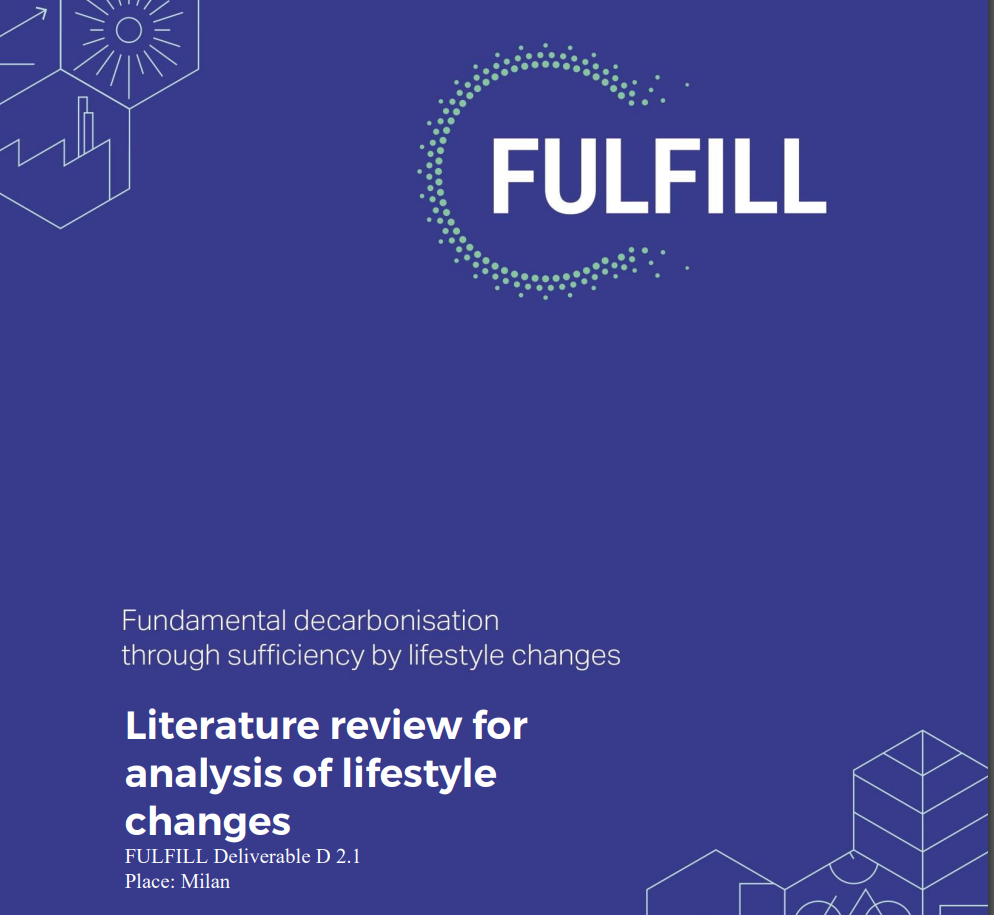FULFILL First Project Results
“Language is a model, a picture of reality”
Ludwig Wittgenstein
Tractatus Logico-Philosophicus 1921
Choosing the right words to define sufficiency is crucial to explaining how it works and understanding its impacts on climate change mitigation. That’s why the first result of the FULFILL research project is a thorough literature review of the concept of sufficiency, led by eERG-Politecnico di Milano!
What is sufficiency?
FULFILL understands sufficiency as “creating the social, infrastructural, and regulatory conditions for changing individual and collective lifestyles in a way that reduces energy demand and greenhouse gas emissions to an extent that they are within planetary boundaries, and simultaneously contributes to societal well-being”.
Within the concept of sufficiency, the ecological and social aspects go hand-in-hand. The following Doughnut shows two rings: one describing the necessity to not overshoot planetary boundaries (ecological ceiling), and one showing that we must not fall short on the elements that help us create a just society in which everyone can thrive (social foundation). The goal of sufficiency is therefore to hit the sweet spot between these two, which would allow people to live a good life without destroying the planet.

To stay within planetary boundaries and effectively mitigate climate change, the recent IPCC report emphasizes the need to combine renewables and efficiency with sufficiency measures.
While there is an urgent need for rapid substitution of fossil by renewable energy sources (consistency), energy use is still growing fast; as a result, the percentage of renewables of total energy use remains the same, which underlines the need for sufficiency.
Similarly, making processes more efficient – using less energy to accomplish the same results – is necessary, but does not guarantee an overall reduction of energy use.
In fact, despite major gains in efficiency, total energy use on a global level continues to grow. This is partly due to the rebound effect, which occurs when increases in efficiency are offset by a rise in consumption. For example, the climate benefits of spending less money on fuel for an efficient car are canceled out if the savings are used to refuel and drive the car more often.
Therefore, sufficiency must come into play in order to meaningfully reduce our energy use.
|
|
EFFICIENCY (Less energy use for same result) |
CONSISTENCY (Renewables) |
SUFFICIENCY (Lifestyle Change) |
|
|
Transport |
Fuel-efficient |
Vehicles |
Public |
Teleconferencing, walking, cycling |
Table 1, page 13 from D 2.1 Literature review for analysis of lifestyle changes
Based on our literature review, sufficiency can be understood through sufficiency habits, which are individual lifestyle changes (e.g. regularly biking to work), and sufficient infrastructures (e.g. networks of bike lanes). These are influenced by societal frameworks such as laws, regulation and social norms (e.g. 20 or 30 km/h speed limits in urban settings).
Infrastructures
While individual sufficiency habits, such as choosing plant-based diets, biking, or repairing goods, can help combat environmental issues and injustice, they cannot be implemented without the necessary infrastructures. Sufficiency thus depends on the appropriate infrastructures, policies, and social norms that make it easy and rewarding to adopt these individual habits.
The problem is that current policies often favor unsustainable consumption patterns, such as a lack of taxation on kerosene, on the basis that sufficiency infrastructure is too expensive or slow to implement. However, it is actually quite feasible. For example, Paris developed a network of bike paths that extends over 1000+ km, reduced car speed to 20 and 30 km/h for the majority of roads, installed 60 thousand bike parking spots and created pedestrian areas along the river, all in a matter of a few years.
This goes to show that sufficient infrastructures are very much possible; it is just a matter of pushing for their implementation at the policy level.
Social Justice
The sweet spot represented in the doughnut aims to show that sufficiency measures should not leave anyone behind, and should be able to fulfill everyone’s basic energy needs.
While the current discourse encourages individuals to use sufficiency habits to tackle environmental crises, it is important to recognize that many people already do so out of necessity. For example, reducing heating is not possible for everyone, as 35 million Europeans struggled to heat their homes in 2020.
Environmental inequalities exist among both social classes and countries. The literature review notes that the current “average carbon footprint of an individual belonging to the richest 1 % at the global level can be up to 175 times bigger than the one of an individual belonging to the poorest 10 % (Otto et al., 2019)”. Similarly, while the Global North, which accounts for a much smaller proportion of the world’s population, has exceeded its fair share of the atmosphere by 121%, the Global South is still below its fair share by 12%.
For these reasons, it is necessary to focus sufficiency measures specifically on reducing excess consumption, which is known as consumption beyond one’s basic energy needs. Richer individuals all over the world who tend to consume more energy have a greater responsibility to change their behaviour. Accomplishing this would mean everyone can stay above the social foundation and humanity as a whole does not overshoot the Earth’s capacity to provide resources.
Benefits
Finally, sufficiency can have many societal and individual benefits. It can directly reduce our environmental impact, improve public health and free up public space. For example, in addition to decreasing energy consumption, biking to work reduces noise and improves air quality for everyone!
Reducing energy consumption can also have positive effects on our individual mental and physical health. For example, commuting by bike rather than by car can be a highly beneficial source of exercise and reduce stress.
This highlights the dual benefit of sufficiency: less energy use for the planet and a better quality of life for everyone!
FULFILL seeks to continue spreading the word about sufficiency in order to work toward a healthier society for everyone. Read the full report here!

